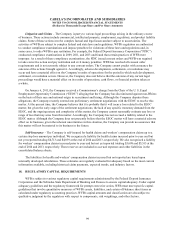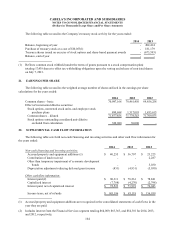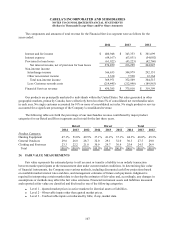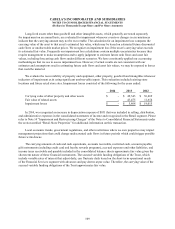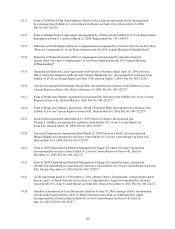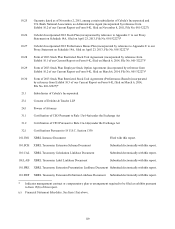Cabela's 2014 Annual Report Download - page 119
Download and view the complete annual report
Please find page 119 of the 2014 Cabela's annual report below. You can navigate through the pages in the report by either clicking on the pages listed below, or by using the keyword search tool below to find specific information within the annual report.
109
CABELA’S INCORPORATED AND SUBSIDIARIES
NOTES TO CONSOLIDATED FINANCIAL STATEMENTS
(Dollars in Thousands Except Share and Per Share Amounts)
Long-lived assets other than goodwill and other intangible assets, which generally are tested separately
for impairment on an annual basis, are evaluated for impairment whenever events or changes in circumstances
indicate that the carrying amount may not be recoverable. The calculation for an impairment loss compares the
carrying value of the asset to that asset’s estimated fair value, which may be based on estimated future discounted
cash flows or unobservable market prices. We recognize an impairment loss if the asset’s carrying value exceeds
its estimated fair value. Frequently our impairment loss calculations contain multiple uncertainties because they
require management to make assumptions and to apply judgment to estimate future cash flows and asset fair
values, including forecasting cash flows under different scenarios. We have consistently applied our accounting
methodologies that we use to assess impairment loss. However, if actual results are not consistent with our
estimates and assumptions used in estimating future cash flows and asset fair values, we may be exposed to losses
that could be material.
We evaluate the recoverability of property and equipment, other property, goodwill and intangibles whenever
indicators of impairment exist using significant unobservable inputs. This evaluation included existing store
locations and future retail store sites. Impairment losses consisted of the following for the years ended:
2014 2013 2012
Carrying value of other property and other assets $ - $ 49,343 $ 30,669
Fair value of related assets - 43,475 11,654
Impairment losses $ - $ 5,868 $ 19,015
In 2014, we recognized an increase in depreciation expense of $831 that was included in selling, distribution,
and administrative expenses in the consolidated statements of income and recognized in the Retail segment. Please
refer to Note 14 “Impairment and Restructuring Charges” of the Notes to Consolidated Financial Statements under
the section entitled “Retail Store Properties” for additional information on this transaction.
Local economic trends, government regulations, and other restrictions where we own properties may impact
management projections that could change undiscounted cash flows in future periods which could trigger possible
future write downs.
The carrying amounts of cash and cash equivalents, accounts receivable, restricted cash, accounts payable,
gift instruments (including credit card and loyalty rewards programs), accrued expenses and other liabilities, and
income taxes receivable and payable included in the consolidated balance sheets approximate fair value given the
short-term nature of these financial instruments. The secured variable funding obligations of the Trust, which
include variable rates of interest that adjust daily, can fluctuate daily based on the short-term operational needs
of the Financial Services segment with advances and pay downs at par value. Therefore, the carrying value of the
secured variable funding obligations of the Trust approximates fair value.


